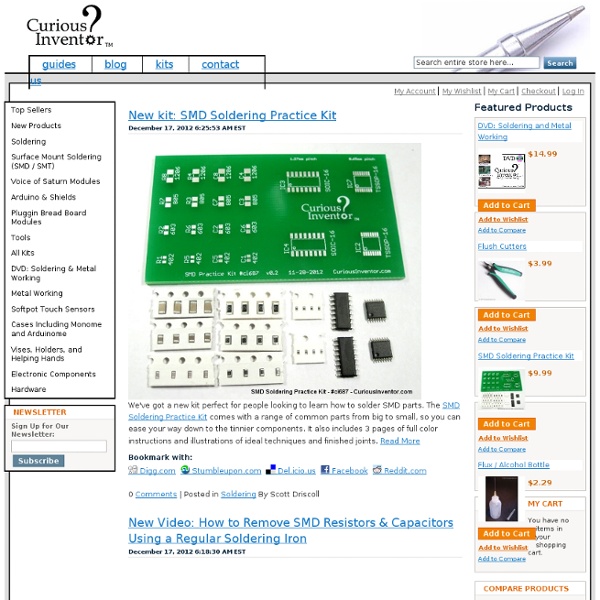Dank
Grbl is a free, open source, high performance CNC milling controller written in optimized C that will run on a straight Arduino. Get the code at Github | Follow Grbl on Twitter MIT Center for Bits and Atoms designed a beautifyl snap fit CNC machine controlled by Grbl. Nortd Labs runs their open source laser cutters with a Grbl-based firmware Who shoud use Grbl
ECE4803B: Theory and Design of Music Synthesizers
Instructor: Prof. Aaron LantermanOffice: Centergy 5212 (often) or Bunger-Henry 323 (rarely) Phone: 404-385-2548 E-mail: lanterma@ece.gatech.edu Course website: users.ece.gatech.edu/~lanterma/ece4803 When and where: MW, 4:30-6:00, Van Leer C457 (sent via real-time video link to GTREP) The photo: Aaron in the beginning stages of putting together the MOTM-485 VCF, which is based on the diode-ring Sallen-Key filter from the Yamaha GX-1 (in case you're wondering, the answer is yes, I am the only prof on my floor with a soldering iron!) Lectures may be downloaded as RealPlayer files. Warning: They're pretty big (150 to 200 MB).
Circuitbenders - Custom built electronic audio insanity machines..........;.url
Grinding Lathe Tools on a Belt Sander – For the New Guy
I’m a believer. As a new guy I totally sucked at grinding lathe tools. It’s almost painful to admit how many stubby, misshapen, multi-faceted, overheated and just plain ugly lathe tools I made back then. The amazing thing is that some of those tools actually worked as well as the pre-ground tools that came with my lathe. I started to believe those guys that tell you, “… just get it close and it will work.”
Math, Physics, and Engineering Applets
Oscillations and Waves Acoustics Signal Processing
Carrion Sound - .url
Grbl development log
First complete job … completed I finished a little Air-app to stream complete jobs to the Grbl and render the result. This is the first “full scale test” running some 7000 lines of sample G-code I scrounged from this thread on CncForum. The Air-app feeds g-code to the microcontroller one line at a time, while the microcontroller generates the steps and feeds them back to be simulated in the Air-app. Everything seems to be working perfectly - the only thing missing now is a test with real steppers on a real machine. You can get the code for the Air-based test-harness at the github-repository
ARM architecture
ARM is a family of instruction set architectures for computer processors based on a reduced instruction set computing (RISC) architecture developed by British company ARM Holdings. ARM Holdings develops the instruction set and architecture for ARM-based products, but does not manufacture products. The company periodically releases updates to its cores. Current cores from ARM Holdings support a 32-bit address space and 32-bit arithmetic; the ARMv8-A architecture, announced in October 2011,[6] adds support for a 64-bit address space and 64-bit arithmetic.
library.thinkquest.org-16497-gather-cgi-bin-projects-1.gif.url
CNC Router Build – The Stand
The stand for my Solsylva 25x25-inch CNC router is made from 1x4-inch pine boards. Two of the supports are hinged so you can fold the router down so it takes up less storage space. Building the stand for my Solsylva 25×25 CNC router was pretty simple.
Patented Dual-Crossbar Architecture for 32-bit ARM Microcontrollers
Silicon Labs’ Precision32™ mixed-signal 32-bit microcontroller devices use a patented dual-crossbar architecture that allows designers to choose peripherals and pinout placement without worrying about pre-set limitations and pin conflicts — simplifying PCB routing, minimizing PCB layers and ultimately reducing design time and system cost. Here's what sets the 32-bit ARM microcontroller apart from the rest: Put Practically Any Peripheral On Any Pin
Retracting Key Ring Corrals Chuck Key
Noticed this write-in tip from Matthew Hakeman in the most recent issue of The Family Handyman. Googling discovered the title image in a thread over at GarageJournal.com, from user evintho. Looks like he’s put a metal strap around the key between the handle and the teeth.



